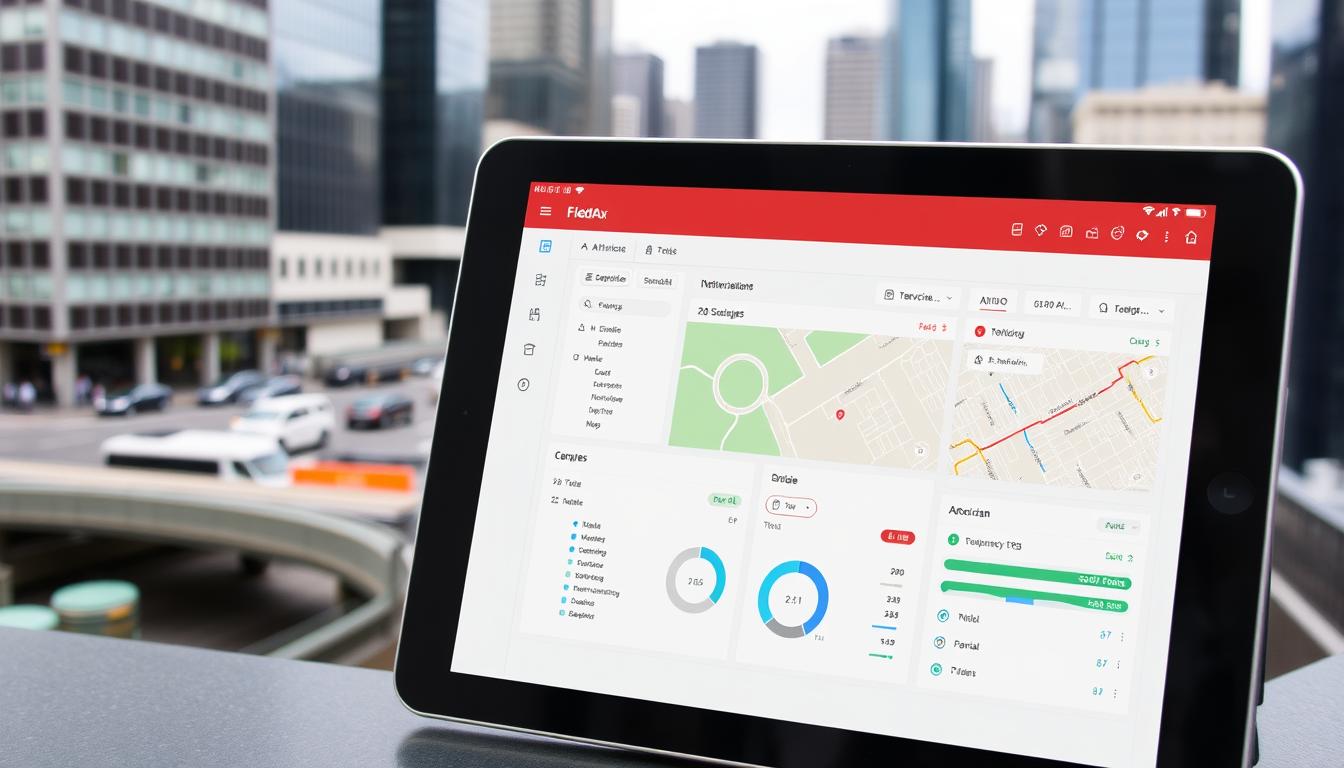Did you know 70% of network outages stem from preventable human errors? As demand for seamless connectivity skyrockets, teams managing vital infrastructure face unprecedented pressure. Enter advanced field service tools – the invisible backbone keeping communication systems operational in our hyper-connected world.
Take Praxedo’s platform, for example. Its intelligent routing slashes travel time by 35% while automating emergency dispatch for urgent repairs. Real-time updates let technicians resolve issues faster, whether they’re troubleshooting fiber lines or installing 5G nodes. Managers gain complete visibility through live dashboards showing crew locations, job statuses, and equipment health metrics.
With 5G deployments accelerating and fiber networks expanding daily, outdated manual processes simply can’t keep pace. Teams using smart scheduling solutions complete 22% more jobs weekly while reducing repeat service calls. Customers notice the difference – companies report 40% fewer complaints after implementing these systems.
But the real magic happens behind the scenes. Predictive algorithms analyze historical data to flag aging hardware before failures occur. Integrated inventory trackers ensure technicians always have the right parts, eliminating frustrating return trips. Mobile apps provide instant access to schematics and troubleshooting guides, empowering crews to fix issues on the first visit.

Key Takeaways
- Real-time updates cut response times by 35% during critical outages
- Automated routing boosts daily job completion rates by 22%
- Predictive maintenance reduces equipment failures by up to 40%
- Mobile access to technical docs improves first-time fix rates
- Live dashboards provide complete operational visibility
- Integrated inventory systems prevent 18% of repeat service calls
Upcoming sections will explore how data analytics transform decision-making and why proactive alerts are revolutionizing network reliability. Let’s dive into the tools reshaping how teams maintain our digital lifelines.
Understanding the Role of Field Service Software in Telecom Maintenance
Keeping communication networks running smoothly requires precise coordination. Teams juggle urgent repairs, equipment upgrades, and tight deadlines daily. Modern field service tools tackle these challenges by merging smart planning with live updates.
Streamlining Technician Routes and Scheduling
Smart routing cuts wasted time. Systems like Praxedo’s SmartScheduler analyze traffic patterns and job priorities to create optimized routes. This reduces drive time by up to 35%, letting crews tackle more tasks each day. Less windshield time also means lower fuel costs and fewer emissions.
Automated dispatching matches jobs to nearby specialists. If a fiber line fails, the closest available expert gets alerted instantly. Managers can adjust assignments on the fly when emergencies arise, preventing delays.
Improving Work Order Management and Reporting
Live updates keep everyone in sync. Technicians use mobile apps to document repairs, snap photos, and submit reports before leaving a site. No more lost paperwork or delayed approvals – data flows directly to central systems.
Accurate records help companies meet strict industry standards. Detailed service histories prove compliance during audits. Customers also appreciate instant status alerts, which build trust and reduce follow-up calls.
Praxedo’s platform redistributes tasks automatically if a crew finishes early or hits a snag. This flexibility helps teams hit 98% of service deadlines while maintaining safety protocols.
Telecom Business Maintenance Software: Enhancing Field Service Operations
What separates top-performing field teams from the rest? Visibility. Modern solutions transform scattered information into clear action plans, giving leaders live insights into every repair, upgrade, and crew movement.
Centralized Data and Real-Time Monitoring
Praxedo’s dashboard acts like an air traffic control system for field crews. Managers see technician locations, active jobs, and equipment statuses across entire regions. During 5G tower installations, this bird’s-eye view helps redistribute tasks instantly when delays occur.
Real-time alerts notify supervisors about stuck work orders. A crew finishing early? The system automatically assigns nearby pending jobs. This dynamic approach slashes idle time by 28% compared to static schedules.
Boosting Technician Productivity and Efficiency
Mobile apps put critical information in technicians’ pockets. One cable provider reduced repeat site visits by 19% after equipping teams with Praxedo’s schematics library and inventory tracker. Crews verify they have correct parts before departing and access repair guides onsite.
Automated reporting cuts paperwork time in half. Photos and notes upload directly from job sites, while digital signatures accelerate approval chains. Customers receive instant updates through integrated portals, reducing status inquiry calls by 35%.
Leveraging Advanced Analytics and Fleet Maintenance Solutions
Imagine knowing about equipment issues nine days before they disrupt service. Modern analytics turn this vision into reality by transforming raw data into actionable foresight. Platforms like Pitstop’s fleet solution merge sensor readings, fault codes, and vehicle telematics to predict problems most teams would miss.

Predictive Maintenance and Proactive Alerts
Early warnings prevent 73% of unexpected breakdowns in field operations. Pitstop’s algorithms analyze historical patterns and real-time engine data to flag at-risk assets. One major provider avoided $13.8 million in repair costs last year using these alerts to schedule preemptive fixes during routine maintenance windows.
Automated notifications give crews time to order parts and plan repairs without rushing. This approach slashes overtime costs and keeps fleets road-ready. Teams fix issues during planned downtime instead of scrambling during emergencies.
Consolidated Data Analysis for Better Decision-Making
Combining maintenance records with GPS tracking reveals hidden inefficiencies. Managers spot which vehicles need replacement sooner or identify routes causing excessive wear. Data-driven choices cut fuel use by 18% in one regional network by optimizing dispatch patterns.
Unified dashboards show asset health scores alongside work order backlogs. Leaders balance urgent repairs with long-term equipment investments confidently. This big-picture view helps allocate budgets where they’ll have the greatest impact on service quality.
Innovative Features and Best Practices for Telecom Infrastructure
Staying ahead in infrastructure care means blending innovation with practicality. Modern tools now tackle two critical challenges: meeting strict regulations and adapting to diverse job requirements. Let’s explore how smart features elevate operational standards.
Dynamic Checklists for Regulatory Compliance
Siterra’s mobile solution redefines compliance. Its checklists automatically update based on location and job type. When technicians arrive at a cell tower, the app displays region-specific safety protocols. This real-time guidance helped one provider slash compliance fines by 67% last year.
Digital checklists prevent skipped steps. Photos and timestamps attach directly to reports, creating audit-proof records. Managers review submissions instantly instead of waiting for paper trails.
Customizable Work Order Processes and Mobile Access
No two repair jobs are identical. Platforms like Siterra let teams create templates for common tasks while allowing on-the-fly adjustments. Technicians modify checklists mid-task if they discover unexpected issues during fiber installations.

Real-time mobile access keeps crews agile. Updated schematics push to devices automatically when designs change. One team reduced repeat site visits by 31% using live inventory tracking to verify part availability before dispatch.
American Tower’s success story shows the power of these tools. Their crews now complete 28% more jobs weekly while maintaining 99.7% compliance rates. Adopting similar practices could help your team work smarter, not harder.
Conclusion
In an era where connectivity is king, reliable tools are non-negotiable for infrastructure teams. Platforms like Praxedo and advanced fleet analytics prove that smart systems transform how crews operate. These solutions slash drive times, predict equipment needs, and keep specialists informed through live updates.
Modern field service management thrives on three pillars: precision scheduling, instant visibility, and proactive care. Automated routing ensures technicians arrive faster, while dashboards track progress across multiple jobs. Predictive alerts give teams days—not minutes—to address potential issues before outages occur.
The results speak volumes. Companies using these tools report fewer repeat visits, higher first-time fix rates, and 40% fewer emergency dispatches. Crews gain hours back each week through mobile access to schematics and automated reporting.
Ready to see the difference? Explore demos of leading platforms tailored for infrastructure teams. Equip your crew with systems that turn chaos into clarity—because every minute saved strengthens the networks we all rely on.
See how FieldAx can transform your Field Operations.
Try it today! Book Demo
You are one click away from your customized FieldAx Demo!
FAQ
How does field service management software improve scheduling for technicians?
It uses smart route optimization to reduce travel time and automatically assigns jobs based on location, skill sets, and availability. This ensures faster response times and fewer delays.
Can this software help teams stay compliant with industry regulations?
Yes! Dynamic digital checklists ensure every task meets compliance standards. Automated reminders and audit trails keep teams accountable and reduce risks during inspections.
What real-time features support better decision-making?
Live monitoring tools track technician progress, equipment status, and job completion rates. Managers get instant updates through dashboards, allowing quick adjustments to workflows or resource allocation.
How does predictive maintenance reduce downtime for telecom networks?
Advanced analytics identify potential equipment failures before they happen. Proactive alerts let teams schedule repairs during low-demand periods, minimizing service disruptions.
Can field crews access job details without an internet connection?
Absolutely. Mobile apps with offline functionality let technicians view assignments, update work orders, and sync data once connectivity is restored, ensuring seamless operations in remote areas.
Does the software integrate with existing tools like CRM or billing systems?
Most solutions offer APIs to connect with third-party platforms, centralizing customer data, service histories, and invoicing details in one place for smoother cross-team collaboration.
How does customizable reporting benefit telecom companies?
Tailored reports highlight key metrics like job completion rates, asset performance, and labor costs. These insights help optimize workflows, allocate budgets wisely, and improve service quality over time.
Author Bio
Co-Founder & CMO at Merfantz Technologies Pvt Ltd | Marketing Manager for FieldAx Field Service Software | Salesforce All-Star Ranger and Community Contributor | Salesforce Content Creation for Knowledge Sharing






